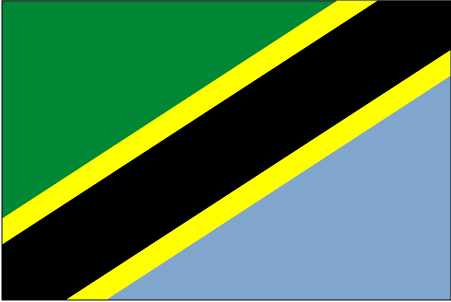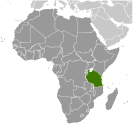
|
|
Advertisements:
People And SocietyNationality
Noun Tanzanian(s)
Adjective Tanzanian Ethnic groups
Mainland - African 99% (of which 95% are Bantu consisting of more than 130 tribes), other 1% (consisting of Asian, European, and Arab); Zanzibar - Arab, African, mixed Arab and African Languages
Kiswahili or Swahili (official), Kiunguja (name for Swahili in Zanzibar), English (official, primary language of commerce, administration, and higher education), Arabic (widely spoken in Zanzibar), many local languages Note Kiswahili (Swahili) is the mother tongue of the Bantu people living in Zanzibar and nearby coastal Tanzania; although Kiswahili is Bantu in structure and origin, its vocabulary draws on a variety of sources including Arabic and English; it has become the lingua franca of central and eastern Africa; the first language of most people is one of the local languages Religions
Mainland - Christian 30%, Muslim 35%, indigenous beliefs 35%; Zanzibar - more than 99% Muslim Population World Ranking: 28
46,912,768 (July 2012 est.)
Note Estimates for this country explicitly take into account the effects of excess mortality due to AIDS; this can result in lower life expectancy, higher infant mortality, higher death rates, lower population growth rates, and changes in the distribution of population by age and sex than would otherwise be expected Age structure
0-14 years
42% (male 9,003,152/female 8,949,061) 15-64 years 55.1% (male 11,633,721/female 11,913,951) 65 years and over 2.9% (male 538,290/female 708,445) (2011 est.) Median age
Total 18.7 years
Male 18.5 years Female 19 years (2012 est.) Population growth rate World Ranking: 55
1.96% (2012 est.)
Birth rate World Ranking: 38
31.81 births/1,000 population (2012 est.) Death rate World Ranking: 31
11.92 deaths/1,000 population (July 2012 est.) Net migration rate World Ranking: 127
-0.29 migrant(s)/1,000 population (2012 est.) Urbanization
Urban population 26% of total population (2010)
Rate of urbanization 4.7% annual rate of change (2010-15 est.) Major cities - population
DAR ES SALAAM (capital) 3.207 million (2009) Sex ratio
At birth 1.03 male(s)/female
Under 15 years 1.01 male(s)/female 15-64 years 0.98 male(s)/female 65 years and over 0.75 male(s)/female Total population 0.98 male(s)/female (2011 est.) Maternal mortality rate World Ranking: 23
460 deaths/100,000 live births (2010) Infant mortality rate World Ranking: 22
Total 65.74 deaths/1,000 live births
Male 72.42 deaths/1,000 live births Female 58.87 deaths/1,000 live births (2012 est.) Life expectancy at birth World Ranking: 205
Total population 53.14 years
Male 51.62 years Female 54.7 years (2012 est.) Total fertility rate World Ranking: 18
5.08 children born/woman (2012 est.) Health expenditures World Ranking: 136
5.1% of GDP (2009)
Physicians density
0.008 physicians/1,000 population (2006) Hospital bed density
1.1 beds/1,000 population (2006) Hiv/aids - adult prevalence rate World Ranking: 12
5.6% (2009 est.)
Hiv/aids - people living with hiv/aids World Ranking: 6
1.4 million (2009 est.)
Hiv/aids - deaths World Ranking: 4
86,000 (2009 est.)
Major infectious diseases
Degree of risk Very high
Food or waterborne diseases Bacterial diarrhea, hepatitis A, and typhoid fever Vectorborne diseases Malaria and plagueWater contact disease Schistosomiasis Animal contact disease Rabies (2009) Children under the age of 5 years underweight World Ranking: 45
16.7% (2005)
Education expenditures World Ranking: 18
6.8% of GDP (2008)
Literacy
Definition
Age 15 and over can read and write Kiswahili (Swahili), English, or Arabic Total population 69.4%Male 77.5% Female 62.2% (2002 census) School life expectancy (primary to tertiary education)
Total 9 years
Male 9 years Female 9 years (2007) Unemployment, youth ages 15-24 World Ranking: 111
Total 8.8%
Male 7.4% Female 10.1% (2005)
Comments
Add a new comment: |
Advertisement
Members area
Tanzania (Dodoma):
 
GPS points from Tanzania (Dodoma)
|
||||||||

 Shortly after achieving independence from Britain in the early 1960s, Tanganyika and Zanzibar merged to form the nation of Tanzania in 1964. One-party rule ended in 1995 with the first democratic elections held in the country since the 1970s. Zanzibar's semi-autonomous status and popular opposition have led to two contentious elections since 1995, which the ruling party won despite international observers' claims of voting irregularities. The formation of a government of national unity between Zanzibar's two leading parties succeeded in minimizing electoral tension in 2010.
Shortly after achieving independence from Britain in the early 1960s, Tanganyika and Zanzibar merged to form the nation of Tanzania in 1964. One-party rule ended in 1995 with the first democratic elections held in the country since the 1970s. Zanzibar's semi-autonomous status and popular opposition have led to two contentious elections since 1995, which the ruling party won despite international observers' claims of voting irregularities. The formation of a government of national unity between Zanzibar's two leading parties succeeded in minimizing electoral tension in 2010.